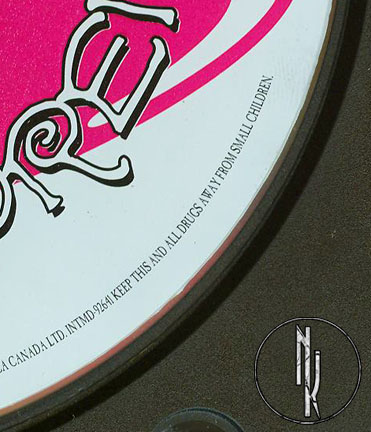the NachtKabarett

All Writing & Content © Nick Kushner Unless Noted Otherwise
-
Manson said that his motive for Smells Like Children was in essence to make a children's album for adults, evoking imagery of the 1970's of his generation and dually portraying certain characters which have much more sinister connotations than simply children's story protagonists. Very similar in a sense how Grimm's fairytales are children's favourites but often have incredibly dark, evil and cannibalistic themes.


Willy Wonka is one such character that Manson was particularly fascinated with throughout Portrait Of An American Family and Smells Like Children, Wonka being certainly child's ideal playmate but one who can also be viewed as a pied piper with a dark ulterior motive behind his colorful outward persona.
Examples of Manson evoking Wonka are numerous, from the Dope Hat video being a surreal and nightmare version of the Chocolate Factory to lyrical references and samples (many of which were removed due to copyright licensing issues on the proper release) to Manson stylizing the 'Marilyn Manson' logo as a parody of Willy Wonka's signature font and logo.
-

 Manson, Circus magazine May 1996 , his first mainstream nationwide cover appearance
Manson, Circus magazine May 1996 , his first mainstream nationwide cover appearance
Marilyn Manson's first (or at least major) nationwide cover appearance was the May 1996 issue of Circus magazine, shortly after the 'Sweet Dreams' video projected the band into mass marketed notoriety. Though Manson has never made any direct nods to Alice Cooper, the dark and evil female first-named godfather of 'Shock Rock', Manson's wardrobe on this cover which introduced him to the mainstream is a very direct, albeit strategically subtle nod to Alice.

 Alice Cooper onstage at the 1969 Toronto Rock 'n Roll Revival where he earned international notoriety by throwing a chicken into the audience
Alice Cooper onstage at the 1969 Toronto Rock 'n Roll Revival where he earned international notoriety by throwing a chicken into the audience
Aside from onstage self-beheadings and music infinitely more abrasive than the contemporary music of his peers in the late sixties, Alice Cooper's first act which earned him his everlasting notoriety occurred at the 1969 Toronto Rock 'n Roll Revival where a fan threw a live chicken onstage during his band's performance. Alice rather cavalierly threw the chicken back into the audience believing it would fly away. When it didn't the audience ripped the chicken to pieces, throwing it's dismembered body parts back onstage whilst it's feathers floated throughout the stage like confetti. It was this, unintentional act, which seared Alice Cooper's name into the subconscious of America which lasts to this day, and plastered his photo on the covers of tabloids across North America.
Though the image are not the most descript, Manson's outfit on the May 1996 cover of Circus was a variation of what Alice wore in September 1969 during the infamous "chicken incident".
Ironically, Manson would later (and falsely) be accused of mutilating chickens onstage and throwing puppies into the audience for the audience to dismember, as history repeats itself.

The live stage backdrop to 1995's 'Smells Like Children' Tour was a stylized 'Marilyn Manson' Ouija board, one of the most common and insidious forms of alleged divination, ironically mass marketed and sold as a children's board game to this day by Parker Bros.
...And the Ouija board, of course, has always been something that I experimented with as a kid that was exhilarating and scary at the same time because you really couldn't decide what was answering your questions. Was it the deepest recesses of your mind or was it some sort of unexplainable force that you can't see? It was always so interesting that it was sold as a children's game... I had some strange experiences. And also I thought since much like the telephone is in your everyday life, the Ouija board is a symbol of communication, so I thought it was appropriate to put on our stage since I'm trying to relay certain ideas that I've obtained from sources. So that was symbolic of that.Marilyn Manson, published in Movie Mirror's 'Marilyn Manson plus other Shock Rockers', October 1997
 Then guitarist, Daisy Berkowitz, also frequently played during the 'Portrait...' and 'Smells Like Children' eras a guitar whose body was styled after a Ouija board. The above is a screen caption from 1994's 'Get Your Gunn' video.
Then guitarist, Daisy Berkowitz, also frequently played during the 'Portrait...' and 'Smells Like Children' eras a guitar whose body was styled after a Ouija board. The above is a screen caption from 1994's 'Get Your Gunn' video.
A subtlely disguised inscription atop the Smells Like Children disc reads, "Keep This and All Drugs Away from Small Children".
-

The cover image of Smells Like Children is Manson portraying himself as "The Child Catcher" from the film 'Chitty Chitty Bang Bang', who is able to smell children in order to capture them. The third track on the EP, 'Shitty Chicken Gang Bang', is a parody of the film's title.
Note the all black attire, long raven hair and large bulbous nose as an immediate (and a largely natural) visual parallel to Manson.
'Chitty Chitty Bang Bang' was also screenplay written by Roald Dahl, the very same author of 'Charlie and the Chocolate Factory' aka 'Willy Wonka' whom Manson has continually evoked and hailed as a dark, insidious pied piper-esque character in the guise of a children's hero.

